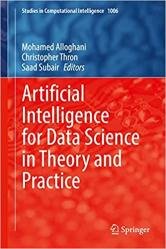 Название: Artificial Intelligence for Data Science in Theory and Practice
Название: Artificial Intelligence for Data Science in Theory and PracticeАвтор: Mohamed Alloghani, Christopher Thron, Saad Subair
Издательство: Springer
Год: 2022
Страниц: 258
Язык: английский
Формат: pdf (true), epub
Размер: 30.4 MB
This book provides valuable information on effective, state-of-the-art techniques and approaches for governments, students, researchers, practitioners, entrepreneurs and teachers in the field of Artificial Intelligence (AI). The book explains the data and AI, types and properties of data, the relation between AI algorithms and data, what makes data AI ready, steps of data pre-processing, data quality, data storage and data platforms. Therefore, this book will be interested by AI practitioners, academics, researchers, and lecturers in Computer Science, Artificial Intelligence, Machine Learning and Data Sciences.
Statistics has been an essential part of the pure and applied sciences for hundreds of years. Until the advent of computers, statistics was conceived as comprehending all aspects of collecting, analysing, interpreting, and presenting data. Its goal is to convert the large amount of data available into meaningful and useful information. It provides methodologies (such as hypothesis testing) to draw conclusions from dаta: these methodologies depend on well-defined parameters with well-studied properties.
On the other hand, machine learning (ML) refers to the algorithms that construct mathematical models that can be used to make decisions based on the data set under observation. ML algorithms are used for data clustering, classification, or prediction, where the decision process itself depends on the data and not the instructions inside the algorithm (or computer program). ML has become a fundamental tool in applied sciences. Many if not most state-of-the-art technological innovations now involve ML processes.
We may contrast statistics with ML as follows. In a conventional statistical data analysis, an algorithm (i.e. fixed procedure, usually implemented as a computer programme) is applied to the input data to compute characteristic parameters (such as mean, variance, etc.) according to definite mathematical formulas. On the other hand, a machine learning approach scans the data (often multiple times) and employs an optimization process to obtain model parameters which usually have no direct interpretation.
Artificial Intelligence (AI) is the imitation of human intelligence in machines that are programmed to think like humans and mimic their actions and behaviour. It refers to tasks that require human-like intelligence, such as vision (computer vision) and perception, speech recognition, and language translation, prediction and classification. AI is an interdisciplinary science with multiple fields and approaches that interact with each other.
Big data refers to exceedingly large datasets (often measured in gigabytes or terabytes) that can be processed by computing to expose patterns, trends, and associations, especially relating to human behaviour and interactions. The size and complexity of big data means that none of the traditional data management tools can process it efficiently. Most important in big data are characteristics concerning its large volume, high throughput, and extreme variability.
The field of Data Science can be broadly construed as extracting value from data. It includes statistics, AI, ML, Big Data, and programming.
Скачать Artificial Intelligence for Data Science in Theory and Practice